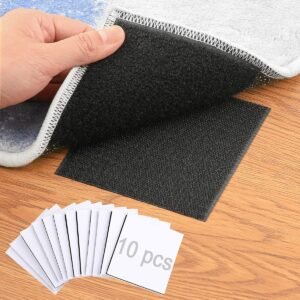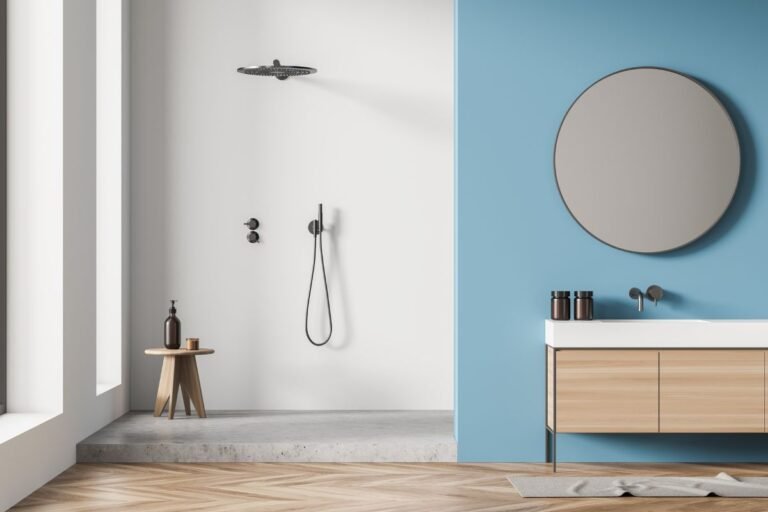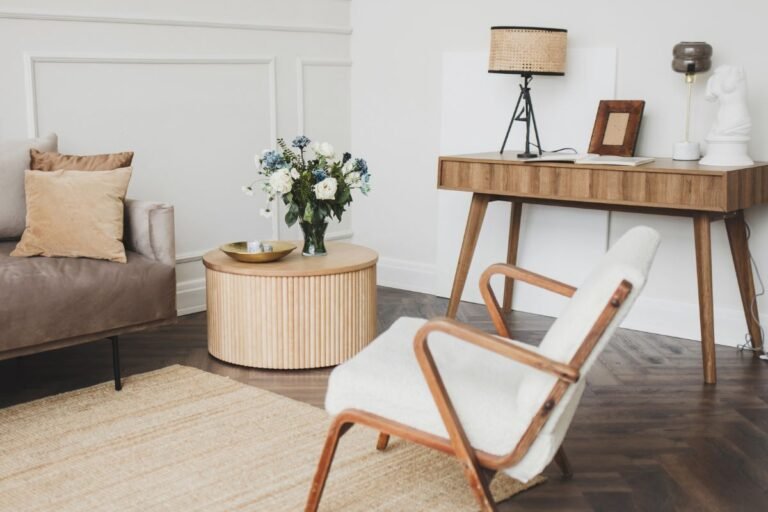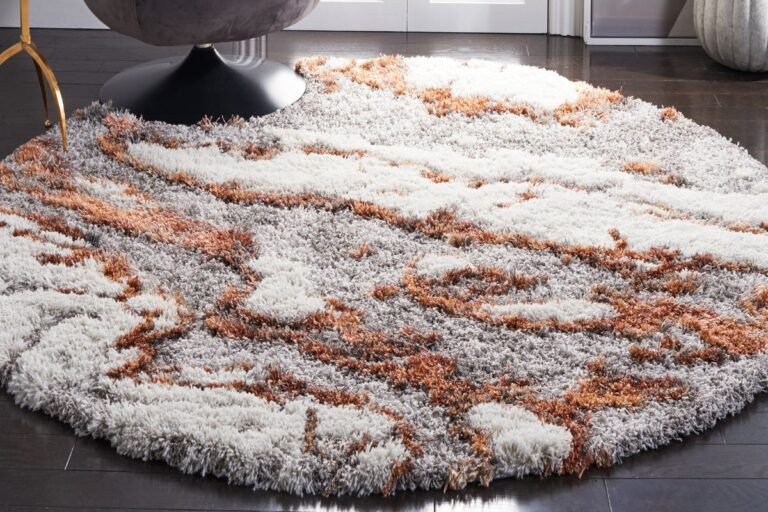Living in perpetually warm climates, I’ve had my fair share of tile flooring.
While this means cooler temps on my soft toesies, it always means that my GD area rugs slide around on these tiles more than I’m willing to put them back into place.
I’ve tried a few things but putting a rug pad underneath is always the best. I’ll go through the different options anyways because, well, I tried them too. But they weren’t as reliable and also I’ve always just been paranoid that I’d ruin my tile flooring.
Anyway, here’s how to keep rugs from slipping on tile based on my experience living in tropical climates.
Use a rug pad
A high-quality rug pad with natural rubber backing is the most effective way to keep area rugs from slipping and sliding on tile floors. Choose a rug pad specifically designed for use on hard floors like tile, as they will have a non-slip surface that grips both the rug and the tile to keep them securely in place.
While most non slip rug pads will be made with some kind of rubber backing or latex, I recommend always choosing a natural rubber rug pad. Natural rubber not only reduces rug slippage (like, completely) but it is also safe for most floor surface types… Including hardwood floors and laminate floors.
So only choose a non slip pad made with natural rubber, just to be 100% certain that you won’t mess up your floors.
Here are some key factors to consider when choosing a rug pad for tile floors:
- Non-slip material: The rug pad should have a non-slip material on the side that will come into contact with the tile floor. Natural rubber, felt, and natural materials like wool or jute are good options as they provide excellent traction.
- Proper thickness: The rug pad should be thick enough to provide cushioning and protection for your tile floor, but not so thick that it raises the rug too high off the floor. A rug pad thickness of around 1/4 inch is usually sufficient.
- Breathability: A breathable rug pad is important to allow air to circulate under the rug and prevent moisture buildup, which can damage tile floors. Natural materials like wool or jute allow for air circulation.
- Durability: The rug pad should be able to withstand foot traffic and the weight of heavy furniture without breaking down or losing its grip.
- Chemical-free: The rug pad should be free from any harmful chemicals or adhesives that can damage tile floors or emit unpleasant odors. This is why I really like the rug pads from RugPadsUSA. They have the most eco-friendly, floor-safe materials on the market.
Some materials commonly used for rug pads that work well on tile floors include natural rubber, felt, wool, and jute. Natural rubber and felt are more common, as they provide a good grip and are durable. Wool and jute are also good options, as they are breathable and provide a cushioning effect.
As for thickness, a rug pad that is around 1/4 inch thick is usually sufficient for tile floors. This thickness provides enough cushioning to protect the tile floor, while still allowing the rug to lie flat on the floor.
To help you choose a rug pad that works well for your tile floors, let me walk through my thought process.
Tiles can be made from a variety of materials, including ceramic, porcelain, natural stone, and glass. The type of tile and its composition can affect its durability, water resistance, and overall quality.
When it comes to using a rug pad on tile floors, breathability is important to prevent moisture buildup that can lead to mold and mildew growth. If a rug pad traps moisture between the rug and the tile floor, it can damage the tile and also cause unpleasant odors.
Felt and natural rubber are both safe and breathable materials for use with tile floors. Felt is made from compressed fibers, often wool, and is naturally breathable. The small air pockets in the felt allow for air circulation, which helps prevent moisture buildup. In addition, felt is a soft, cushioned material that provides a comfortable surface for your area rug.
Natural rubber is also a breathable material that is safe for use on tile floors. It provides excellent traction and can help keep your area rug in place, without damaging the tile floor. Natural rubber is also durable and resistant to wear and tear, making it a good option for high-traffic areas.
Both felt and natural rubber rug pads are available in a variety of thicknesses to suit different rug types and flooring needs. When choosing a rug pad, be sure to select one that is specifically designed for use on hard floors, like tile. This will ensure that the pad is safe, effective, and will not damage your flooring.
I made this handy quiz to recommend a rug pad for your flooring 🙂
Not sure which rug pad to get?
Take the quiz to get started!
We recommend:
Otherwise, this is what I recommend from RugPadUSA:
For high traffic areas with a low profile
This rug pad (Super-Lock Natural) is perfect for high traffic areas or places that need low profiles, like under doorways, or super thin mats. It is made of natural rubber and is safe for all floor types (except Vinyl). It’s super grippy and honestly just the best option for something subtle.
For a little cushion and lots of grip
For a little more cushion but not enough to become a tripping hazard, the Contour-Lock is a great option. I like it for high traffic areas instead of the Super-Lock Natural because it feels good under the feet… especially if you’re walking along it often. Think: hallways, entryways, large spaces.
For lots of cushion and lots of grip
This is great if you definitively want both cushion and grip. This might be good for common areas or places that could use some comfort but not too thick of a rug pad.
For LOTS of cushion and no grip (best for larger area rugs)
If you have tile in your living room, then THIS is the rug pad for you. Get the comfort and luxury of memory foam but the easy-to-clean tile floors your place comes with. I’m obsessed with this rug pad and put it everywhere plausible in my home.
Apply double-sided tape
Double-sided carpet tape (AKA rug tape or rug gripper) can be a quick and easy solution for keeping area rugs in place. To make rugs non-slip, simply apply the rug tape to the underside of the area rug and press firmly onto the tile floor.
Be sure to choose a tape that is safe for use on tile floors, as some types of adhesive can damage the surface. It is also a good idea to test a small, inconspicuous area of the tile floor first to ensure that the tape does not cause any damage. If the tape does leave a residue on the tile, you can use a mild cleaning solution to remove it.
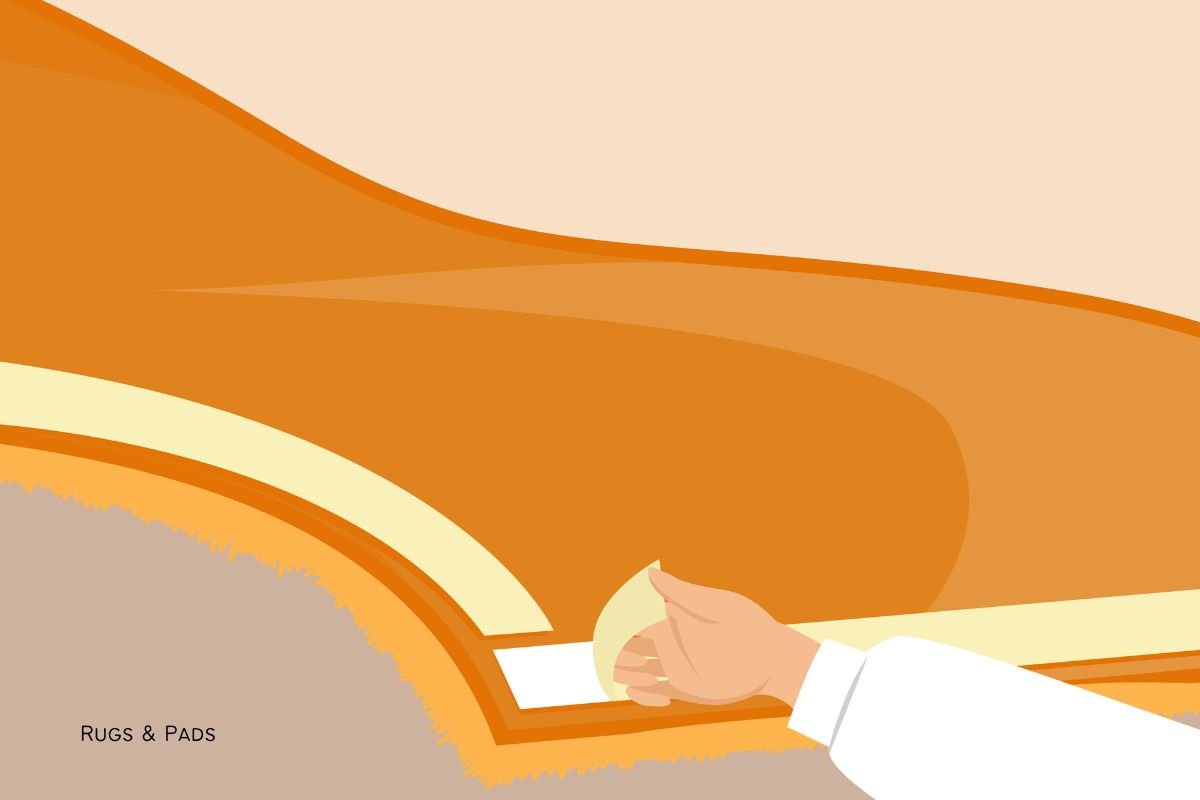
Here are some steps to follow when applying double-sided tape to an area rug:
- Clean the tile floor: Make sure the tile floor is clean and dry before applying the carpet tape. Any dirt or debris on the tile can affect the tape’s adhesive properties.
- Cut the tape: Cut the carpet tape into pieces that are slightly shorter than the width of the rug.
- Apply the tape: Peel off the backing from the tape and apply it to the underside of the rug along the edges and corners. Be sure to apply the tape in a straight line and avoid folding or creasing the tape, as this can reduce its effectiveness.
- Press the rug onto the tile: Carefully place the rug onto the tile floor, making sure it is properly aligned. Press down firmly on the rug to help the tape adhere to the tile.
When applying rug grippers to an area rug on tile flooring, it is important to use a tape that is specifically designed for use on hard floors. Some types of adhesive, which is made of synthetic materials, can damage tile surfaces, so make sure the tape you choose is safe for use on tile.
If you are concerned about the gripper tape leaving a residue or damaging your tile floors, then you may want to consider using a rug pad instead. A high-quality rug pad specifically designed for use on hard floors can be a safe and effective alternative to carpet tape.
Apply silicone caulking
Silicone caulk can be an effective way to keep rugs from sliding on tile floors. When applied correctly, silicone caulking provides a non-slip surface that adheres to both the rug’s fibers and the tile floor, helping to keep the rug in place.
To apply silicone caulking to an area rug, you will need the following materials:
- A tube of silicone caulking
- A caulking gun
- A pair of scissors
- A putty knife
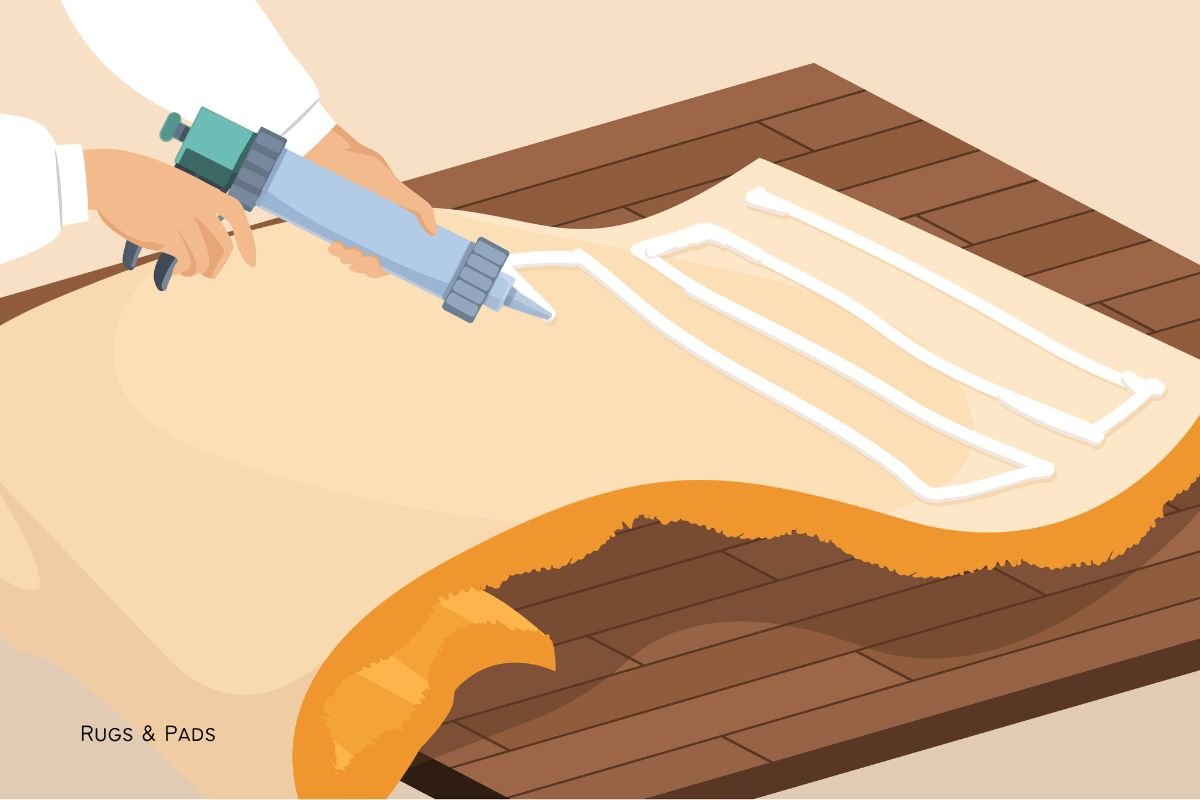
Here are the steps to follow:
- Clean the area of the tile floor where the rug will be placed. Make sure the surface is free of dust, dirt, and any other debris.
- Cut the tip of the silicone caulking tube at a 45-degree angle, using the scissors. This will create a small opening that will allow you to control the flow of the caulking.
- Load the silicone caulking tube into the caulking gun and squeeze the trigger until the caulking begins to flow. It’s a lot like a hot glue gun, only bigger and more permanent.
- Apply a continuous bead of silicone caulk along the underside of the rug, near the edges. The bead should be about 1/4 inch thick.
- Carefully place the rug onto the tile floor, making sure it is properly positioned.
- Use a putty knife to smooth out the silicone caulking and press it firmly onto the tile floor. Make sure the caulking is evenly distributed and covers the entire surface of the rug’s underside.
- Allow the silicone caulk to dry completely, following the manufacturer’s instructions. This may take several hours.
When applying silicone caulking to an area rug, it’s important to avoid getting the caulking on the tile floor itself, as it can be difficult to remove and may damage the surface. To prevent this from happening, apply the caulking in a continuous bead along the outer edges of the rug, leaving a small gap between the caulking and the edge of the rug. This will allow the rug to lie flat on the tile floor while still providing a non-slip surface.
If you want to remove the rug in the future, you can use a putty knife to carefully separate the silicone caulking from the tile floor, taking care not to damage the surface. It’s also a good idea to test a small area of the tile floor with the silicone caulking first to ensure that it does not cause any damage or discoloration before applying it to the entire rug.
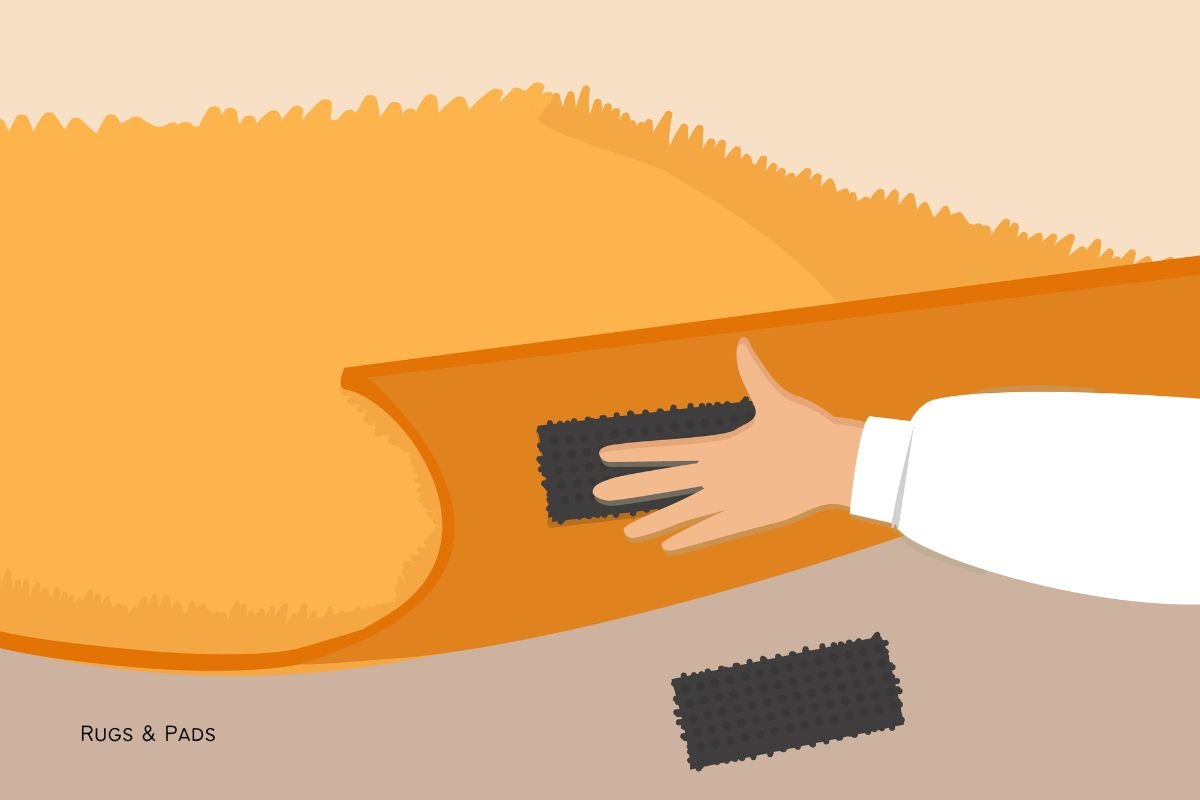
Apply Velcro strips
Velcro strips can be a quick and easy way to keep an area rug from slipping on tile floors, and when applied correctly, they should not damage the tile flooring.
Here’s how to use Velcro strips to keep your rug in place on a tile floor:
- Choose the right type of Velcro strips: Make sure you choose Velcro strips that are designed for use on hard surfaces like tile floors. These should be labeled as “removable” or “indoor/outdoor” and should not have an adhesive that is too strong that can damage the tile.
- Cut the Velcro strips to size: Measure each corner of the rug and cut the Velcro strips to match the size of the corner. Be sure to use a pair of scissors or a cutting tool that will not damage the Velcro strips. I really like other hook-and-loop type adhesives that are more of a patch that you place in the corners of your area rug instead of actual strips. It’s up to you what you prefer.
- Attach the Velcro strips to the rug: Peel the backing off of one side of the Velcro strip and press it firmly onto the corner of the rug. Repeat for all four corners of the rug.
- Attach the Velcro strips to the tile floor: Peel the backing off of the other side of the Velcro strip and press it firmly onto the tile floor. Make sure the strip is aligned with the strip attached to the rug.
Here are a few tips to help ensure that you don’t damage the tile flooring:
- Before applying the Velcro strips, make sure the tile floor is clean and free from any debris or dirt that could interfere with the adhesive.
- Avoid using any Velcro strips that have a strong adhesive that is designed for use on walls or other surfaces, as these can be difficult to remove and can potentially damage the tile floor.
- Test the Velcro strips on a small, inconspicuous area of the tile floor before applying them to the entire rug, to make sure they do not leave any residue or damage the surface.
- When it’s time to remove the Velcro strips, be sure to pull them off gently, using a slow and steady motion. If any residue remains on the tile floor, you can use a cleaning solution specifically designed for tile floors to remove it.
Closing thoughts
Do yourself a favor and go with the rug pad. If you have heavy furniture, like a coffee table or couch, then go with the Cloud Comfort Memory Foam. Give yourself some cushion since the furniture legs are likely to keep large rugs from slipping. For small rugs, go with the Super-Lock Natural or the Superior Lock. They both are non slip rug pads, but one has a low profile and the other provides a bit of cushioning. Good luck and let me know about your experience!
More About Rug Pads
- The 5 Best Rug Pads for Hardwood Floors
- How To Secure Area Rug On Top Of Carpet (The Safe Way)
- Best Non-Toxic Rug Pads Safe For Children And Pets
- How To Size A Rug Pad, Expert Tips
- The Best Memory Foam Rug Pad for Maximum Comfort
- Best soundproofing rug pads: 3 options for a quiet barrier
- This Is The Best Rug Pad For Vinyl Plank Flooring
- Rug Pad Thickness Guide: How To Choose Rug Pad Thickness










